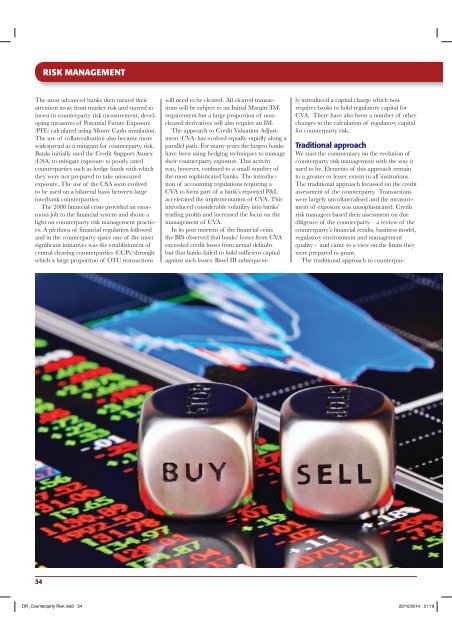SOURCE: Derivatives Special Report
SOURCE Derivatives Special Report provides expert analysis and information on the derivatives markets and provides insight into the large and complex challenges being faced by the global derivatives industry. SOURCE Derivatives Special Report strives to identify emerging risks and mitigation strategies, while covering the fascinating people who drive the industry forward. The magazine will be published in June and November 2015 and quarterly from 2016 with the launch of our website, sourcederivatives.com in September 2015. SOURCE Derivatives Special Report is the leading analytical publication on derivatives, providing a detailed study of theoretical models and how they are used in practice. SOURCE Derivatives Special Report gives you results-oriented analysis and statistical information on derivative products and techniques.
SOURCE Derivatives Special Report provides
expert analysis and information on the derivatives
markets and provides insight into the large and
complex challenges being faced by the global
derivatives industry.
SOURCE Derivatives Special Report strives to
identify emerging risks and mitigation strategies,
while covering the fascinating people who drive
the industry forward.
The magazine will be published in June and
November 2015 and quarterly from 2016 with
the launch of our website, sourcederivatives.com
in September 2015.
SOURCE Derivatives Special Report is the
leading analytical publication on derivatives,
providing a detailed study of theoretical models
and how they are used in practice.
SOURCE Derivatives Special Report gives you
results-oriented analysis and statistical information
on derivative products and techniques.
Create successful ePaper yourself
Turn your PDF publications into a flip-book with our unique Google optimized e-Paper software.
RISK MANAGEMENT<br />
The most advanced banks then turned their<br />
attention away from market risk and started to<br />
invest in counterparty risk measurement, developing<br />
measures of Potential Future Exposure<br />
(PFE) calculated using Monte Carlo simulation.<br />
The use of collateralisation also became more<br />
widespread as a mitigant for counterparty risk.<br />
Banks initially used the Credit Support Annex<br />
(CSA) to mitigate exposure to poorly rated<br />
counterparties such as hedge funds with which<br />
they were not prepared to take unsecured<br />
exposure. The use of the CSA soon evolved<br />
to be used on a bilateral basis between large<br />
interbank counterparties.<br />
The financial crisis provided an enormous<br />
jolt to the financial system and shone a<br />
light on counterparty risk management practices.<br />
A plethora of financial regulation followed<br />
and in the counterparty space one of the most<br />
significant initiatives was the establishment of<br />
central clearing counterparties (CCPs) through<br />
which a large proportion of OTC transactions<br />
will need to be cleared. All cleared transactions<br />
will be subject to an Initial Margin (IM)<br />
requirement but a large proportion of noncleared<br />
derivatives will also require an IM.<br />
The approach to Credit Valuation Adjustment<br />
(CVA) has evolved equally rapidly along a<br />
parallel path. For many years the largest banks<br />
have been using hedging techniques to manage<br />
their counterparty exposure. This activity<br />
was, however, confined to a small number of<br />
the most sophisticated banks. The introduction<br />
of accounting regulations requiring a<br />
CVA to form part of a bank’s reported P&L<br />
accelerated the implementation of CVA. This<br />
introduced considerable volatility into banks’<br />
trading profits and increased the focus on the<br />
management of CVA.<br />
In its post mortem of the financial crisis<br />
the BIS observed that banks’ losses from CVA<br />
exceeded credit losses from actual defaults<br />
but that banks failed to hold sufficient capital<br />
against such losses. Basel III subsequently<br />
introduced a capital charge which now<br />
requires banks to hold regulatory capital for<br />
CVA. There have also been a number of other<br />
changes to the calculation of regulatory capital<br />
for counterparty risk.<br />
Traditional approach<br />
We start the commentary on the evolution of<br />
counterparty risk management with the way it<br />
used to be. Elements of this approach remain<br />
to a greater or lesser extent in all institutions.<br />
The traditional approach focussed on the credit<br />
assessment of the counterparty. Transactions<br />
were largely uncollateralised and the measurement<br />
of exposure was unsophisticated. Credit<br />
risk managers based their assessment on due<br />
diligence of the counterparty – a review of the<br />
counterparty’s financial results, business model,<br />
regulatory environment and management<br />
quality - and came to a view on the limits they<br />
were prepared to grant.<br />
The traditional approach to counterpar-<br />
34<br />
DR_Counterparty Risk.indd 34 20/10/2014 21:18
















